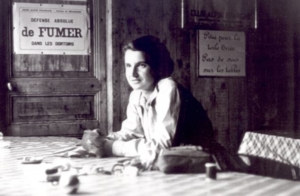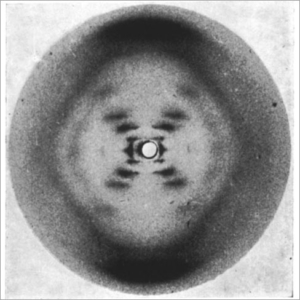Rosalind Franklin
X-ray Crystallographer & Biophysicist
Rosalind Franklin with microscope in 1955 (Image by MRC Laboratory of Molecular Biology on Wikimedia Commons)
- BORN 25th July 1920, Notting Hill, London, England
- DIED 16th April 1958, Royal Marsden Hospital, Chelsea, London, England
- WORKED Cambridge University; British Coal Utilisation Research Association in Kingston-upon-Thames, London; Laboratoire Central des Services Chemique de l’État in Paris; Medical Research Council Biophysics Research Unit, King’s College London; Birkbeck College, London
- HONOURS Sadly, Rosalind Franklin died at the early age of only 37, from ovarian cancer, and so did not receive the official recognition and awards that her work in all three areas to which she contributed – coal and graphite, DNA, and virus structure – would undoubtedly have attracted.
Entry by Brian Sutton, Professor of Molecular Biophysics, King’s College London

Artistic Connections
Happy Birthday Rosalind Franklin Centenary Celebration 25th July 2020
Rosalind enjoyed the theatre and art, but her real passion outside of science was for the outdoors, hiking and especially the mountains.
Rosalind was not musical, to the disappointment of the director of music at her school, a certain Gustav Holst!
Music
Title: VIRUS – in molecular mode
Composer: FRANCES M LYNCH
Text: Frances M Lynch, Dr Rosalind E Franklin
Film: Shelley James
Written: June/July 2020
For: Voices and electronic manipulation
Performed by: Frances M Lynch – Soprano, Jenny Miller – Soprano, Alice Privett – Soprano, Simone Ibbett-Brown – Mezzo, Margaret Cameron – Mezzo, Julian Stocker – Tenor, Gwion Thomas – Baritone, Herbie Clarke – Bass
First Performed: Online during the Covid-19 Outbreak on 25th July 2020
The music is inspired by discussions with Prof Brian Sutton about Franklin’s work on Virus Structure. The text includes quotes from “Structure of Tobacco Mosaic Virus” by Dr Rosalind E Franklin.
You can download the full text of VIRUS here
The piece was constructed from vocal samples and created at Birnam Studios, London as part of electric voice theatre‘s Minerva Scientifica – Connections 2020 project, supported using public funding by the National Lottery through Arts Council England. Frances M Lynch is supported by PRS Foundation’s The Open Fund.
Sampler for The Franklin Effect CD released by First Hand Records
Title: The Franklin Effect – Photo 51, K-Ras, Life Sequences, Theories of Quantum Mechanics
Music by: CHERYL FRANCES-HOAD, LYNNE PLOWMAN, SHIRLEY J. THOMPSON, KATE WHITLEY
In collaboration with: Prof. Elizabeth Kuipers, Dr Claire Sharpe, Prof. Ellen Solomon, Prof. Mairi Sakellariadou
Written in: 2015
For: Vocal Quartet (2 sopranos, counter tenor and tenor)
Performed by: Frances M Lynch, Penny Desbruslais, David Sheppard, Julian Stocker
First Performance: electric voice theatre Franklin Quartet with Prof. Ellen Solomon (speaker), Kings College London, Strand Chapel, 22nd October 2015
In January of 2015 a group of four composers, four scientists and four singers met together at Kings College London in a series of workshops and performance events to create a set of variations on the theme of Rosalind Franklin. The scientists were from a variety of disciplines – Psychology, Renal Sciences, Human Genetics and Theoretical Physics.
The results were recorded and released by First Hand Records – you can find the CD on their site JUST CLICK HERE. For downloads go to Presto Classical.
“Electric Voice Theatre’s wonderfully manicured sound, ultra-clear enunciation of the texts…and marvellously dramatic delivery of texts and music are wholly winning…the myriad styles and resonances in the music are delivered with aplomb…required listening for oh, so many reasons!” (Gramophone)
Extracts from a performance at Warwick University, 2016
For more information about The Franklin Effect Project please visit the electric voice theatre website
Education
Franklin attended St. Paul’s Girls’ School in London, studying Physics, Chemistry and Pure and Applied Mathematics in her final years. She won a place to study Natural Sciences at Newnham College, Cambridge, specialising in Chemistry in her final year.
Occupations
Physical chemist
After studying Natural Sciences (Chemistry) at Cambridge University and undertaking a short research project there, she worked for the British Coal Utilisation Research Association in Kingston-upon-Thames, London; her work there led to the award of her PhD in 1945.
During the Second World War, she investigated the structure of different types of coal, which was important for the war effort and reconciled her father to her chosen career as a scientist.
In 1947 she moved to the Laboratoire Central des Services Chemique de l’État in Paris, where she developed her skills as an X-ray crystallographer.
X-ray crystallographer
X-ray crystallography is a technique used to elucidate the molecular structure of materials, ranging from inorganic minerals to biological specimens. Franklin used her expertise to look at carbon and graphite in coals, and to study the structure of DNA. and viruses.
In 1951 she moved to King’s College London, where she joined the Medical Research Council Biophysics Research Unit analysing DNA.
In 1953 she moved to Birkbeck College, London, where she used X-ray diffraction techniques for her important work on the tobacco mosaic virus.
Scientific Achievement
- Franklin’s X-ray diffraction photographs of DNA at King’s College London made a key contribution to the discovery of the double-helical structure of DNA, arguably the greatest discovery in biology of the 20th century, and one of the greatest of all time, with ramifications for life today from medicine to anthropology to forensic science. The structure led immediately to an understanding of the mechanism of heredity, and later to the way in which information is stored in the DNA molecule, the nature of the gene and the molecular basis of many diseases. At the time, it was not generally agreed that DNA was the genetic material, but determining the three-dimensional structure of DNA revealed the molecular basis of life.
- Her ground-breaking X-ray diffraction studies of tobacco mosaic virus (TMV) at Birkbeck College, carried out with Aaron Klug and others, led to an understanding of the molecular structure of this virus and the way in which the genetic material is encapsulated within the helical protein structure. This was the first detailed structure for any virus and opened up a whole new field. TMV is a plant virus, but X-ray crystallography is still being applied today to understand virus structures and their mechanisms of action, particularly those pathogenic to humans. Franklin’s research laid the first foundations for studies that have led to producing vaccines and treatments to combat infectious viral diseases.
Did You Know?
Although taught at school by world-famous Gustav Holst, Rosalind disappointed him in his belief that “everyone had music in them”.
After finishing a term in Cambridge, she wanted her bicycle at home for the vacation, so she simply rode it to London, a ride of more than 50 miles!
The most famous of her X-ray diffraction photographs, taken whilst working with her PhD student Raymond Gosling, is known somewhat enigmatically as “Photograph 51”. One of a series, it was taken in May 1952 and shows, by its X-shaped pattern, clear evidence for a helical structure.
It was this photograph, seen in early 1953 by James Watson, which enabled James Watson and Francis Cricktto build their model of the double helix. Their structure of DNA was published in the journal Nature in April 1953, alongside a paper by Franklin and Gosling showing Photograph 51 and other information, confirming the Cambridge model, and a third paper from Maurice Wilkins and others at King’s. Rosalind Franklin never knew that Watson had seen Photograph 51 before building Cambridge’s model, nor that he and Crick had also been given access to other key elements of her data; their paper does not appropriately acknowledge this fact.
Poignantly, in a draft manuscript dated 17th March 1953, one day before news of the double helix model in Cambridge reached King’s in London, Franklin described a double-helical structure, with the two coaxial chains off-set from each other in exactly the same way.. She was so close to the answer!
The inscription on her gravestone emphasises the significance of her work on viruses:
“Her research and discoveries on viruses remain of lasting benefit to mankind”
An Inspiring Woman
Rosalind Franklin was an exceptional experimentalist who inspired those around her through her attention to detail, uncompromising approach and above all her dedication to science. In one of her early letters home she wrote:
“Science and everyday life cannot and should not be separated”
In his obituary, J.D. Bernal, Head of the Department at Birkbeck College, wrote:
“As a scientist Miss Franklin was distinguished by extreme clarity and perfection in everything she undertook. Her photographs are among the most beautiful X-ray photographs of any substance ever taken. …[She] inspired those who worked with her to reach the same high standard” (Nature, July 19th 1958).
Despite his high praise, Bernal called her ‘Miss’ rather than ‘Doctor’, just one small indicator of the discrimination female scientists faced on a daily basis. Paid less than men for the same work, women found it difficult to secure the top jobs. In his book “The Double Helix” (1968), James Watson wrote so disparagingly about her that she became a symbol of female victimisation. But as her sister Jenifer Glynn put it in her biography “My Sister Rosalind Franklin” (2012):
“…she was never a feminist – she would have thought of herself simply as a scientist whose achievements should be judged on their own terms, not as ‘woman scientist’ striking a blow for the rights of women”
Fortunately her achievements are now well recognised in their own right, in part through the superb biography by Brenda Maddox, “Rosalind Franklin, the Dark Lady of DNA” (2002). The most famous female British scientist, she serves as an inspiration to women and men alike.

Plaque at King’s College London, Strand Campus, commemorating those involved in the X-ray studies of DNA (Image by Brian Sutton)
- Buildings at St. Paul’s Girls’ School, Newnham College, Cambridge, and at King’s College London, as well as countless others nationwide and worldwide, have been named after her.
- Her story inspired Anna Ziegler to write the play “Photograph 51”, which was performed at the Noël Coward Theatre, London in 2015, with Nicole Kidman playing Rosalind.
- In 2019, following a public call for suggestions, it was agreed that the Mars rover due to be launched in 2020 – the centenary of her birth – to search for evidence of life on Mars, would bear her name. Although the project has now been postponed until 2022, it could not be more appropriate that the search for extra-terrestrial life should be associated with the name of one who made such a vital contribution to the discovery of the molecular basis of life on Earth.




